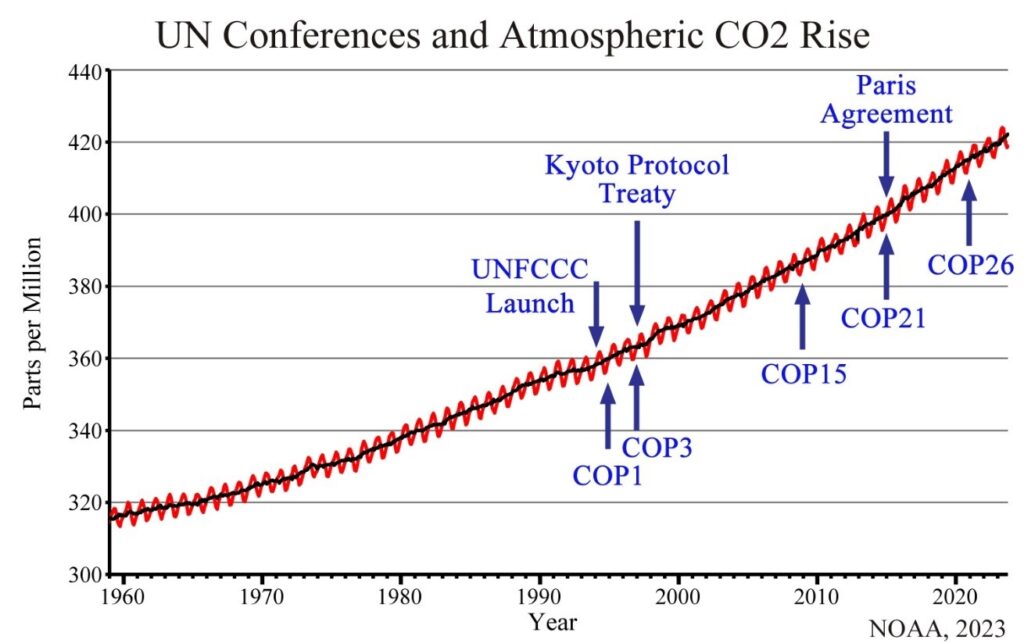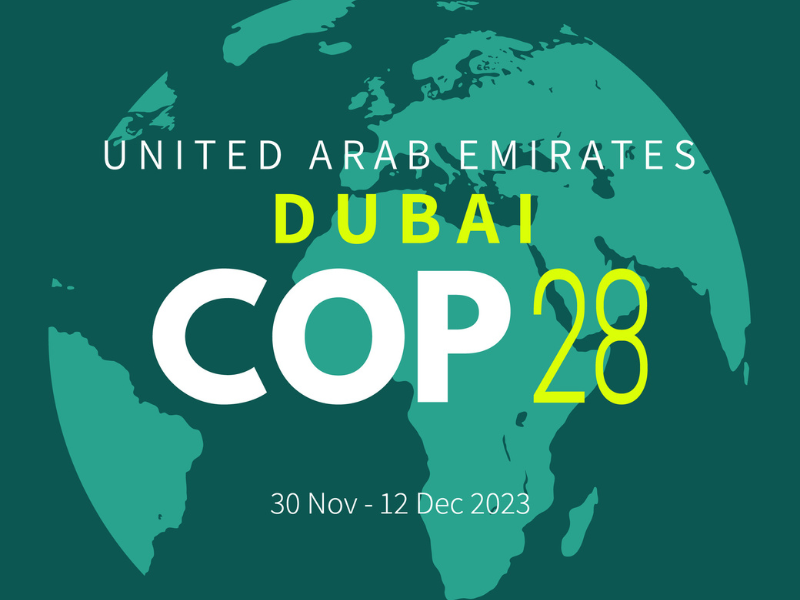The United Nations Climate Conference begins November 30 in Dubai, United Arab Emirates (UAE). More than 70,000 delegates are expected to attend from almost 200 nations. The COP28 event will emit large amounts of carbon dioxide but is unlikely to have any measurable effect on global temperatures.
COP28 is the 28th meeting of the Conference of the Parties, an annual event that has been going on since 1995. The Conference of the Parties is the decision-making body of the Framework Convention on Climate Change (FCCC), which is an international agreement that was established in 1994 by the UN, with the intention of “preventing dangerous human interference with the climate system.”
Pope Francis, King Charles III, Bill Gates, John Kerry, and many other dignitaries will lead the 70,000 attendees. Heads of state, industry and business leaders, leaders of environmental groups, and media representatives will also attend. The Nature Conservancy plans to send representatives from 20 nations.
The attendees will arrive in the UAE primarily by private jet or commercial aircraft, powered by jet fuel. For each kilogram of jet fuel burned, 3.16 kilograms of carbon dioxide (CO2) will be emitted. They will then travel from the airport to Dubai’s Expo City by limousine or taxi, fueled by gasoline or diesel fuel. Some may take electric vehicles, but these EVs will be charged by UAE electricity, 82% of which is produced by natural gas.
And yet, COP28 delegates will inevitably push for the end of the use of hydrocarbon fuels, which are coal, oil, and natural gas. Fatih Birol, the Executive Director of the International Energy Agency, who is likely to attend, stated in 2021, “If governments are serious about the climate crisis, there can be no new investments in oil, gas, and coal, from now—from this year.” Many delegates support Mr. Birol’s statement.
But most of the conference attendees will have cell phones, which are made from plastic from oil or natural gas. They will be wearing suits, ties, shoes, and other clothing, much of which will be composed of synthetic fibers from hydrocarbons. They will dine on food produced by farms that use synthetic nitrogen fertilizer created from ammonia, produced using natural gas or coal fuels. Hydrocarbons drive our modern society.
Developing nations, too, need oil, gas, and coal to raise the standard of living of their people. Renewables provided only a tiny part of the energy consumed in developing countries in 2022, such as in Africa (2.4%), India (5.9%), the Middle East (0.7%), and Southeast Asia (6.3%). More than 1,000 coal-fired power plants are now being planned or under construction across the world.
Ironically, developing countries appear to be all in for world decarbonization, with heavy participation at annual UN climate conferences. Why shouldn’t they be? Poorer nations seek billions in wealth transfers from richer nations in the name of climate change. For example, prior to the COP26 conference in Scotland in 2021, India demanded $1 trillion per year from wealthy countries to help it reach “net zero” by 2070. About 25 percent of all financial aid to the developing world now goes to fund climate-related projects, up from only four percent in 2005.
COP climate conferences are steeped in hypocrisy. John Kerry, the US climate envoy, is well-known for his CO2-emitting private jet flights, but he considers his work too important to travel by alternatives that emit less CO2. Bill Gates, the billionaire, built and owns a 66,000 square foot mansion in Medina, Washington. His home uses more than 20 times the electricity of a typical US home. Climate change advocates demand emissions reductions from society that they are unwilling to observe themselves.
Not that it matters much, anyway. There is little evidence that the annual COP climate conferences held over the last 27 years have had any effect on the climate. Data from the National Oceanic and Atmospheric Administration shows that the concentration of carbon dioxide in our atmosphere continues to rise steadily. In 2020, global industrial emissions of CO2 declined by over eight percent during the COVID-19 crisis, but this decline was undetectable in the rise in atmospheric CO2.

Nor has there been any significant change in energy consumption. World energy consumption has tripled since 1965. From 2004 to 2021, the world spent about $5 trillion to promote renewable energy and installed more than 300,000 wind turbines. But in 2021, coal, oil, and natural gas still provided 81 percent of global energy consumption, the same percentage as in 1999. The COP climate conferences can best be characterized as futile.





